Or rather the first plant I tend to see whenever I step into the garden because it is so bright...
I have been meaning to feature this plant for quite some time now, but like anything else that got side stepped for some reason, never seemed able to until I had a quick wander down the garden earlier today and spotted this plant again, like I always do over and over again. So I thought I should actually take the time now and write this long overdue blog post, which is an homage to this beautiful plant.
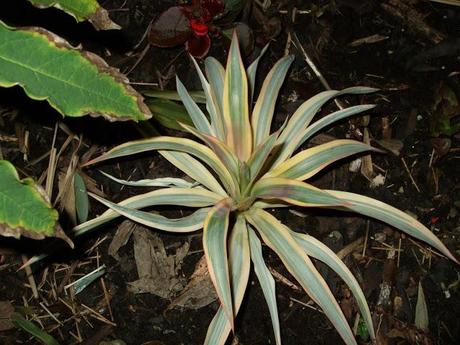
The original plant I bought from CGF - Yucca gloriosa 'Bright Star'
I first spotted this inside one of the polytunnels of CGF back in 2009 and there it was, a Yucca that shines so brightly on the bench and quite unlike any other variegated yucca I've seen before. There were only two then so I felt fortunate enough to be there at the right time to nab one of the two of what was then a very rare plant. It wasn't the rarity that appealed to me, it was simply for what it looked like; bright, iridescent yellow leaves with a matte texture, the habit and elegance of its species which is gloriosa, and hints of pink and red on certain parts of the leaves, lovely!
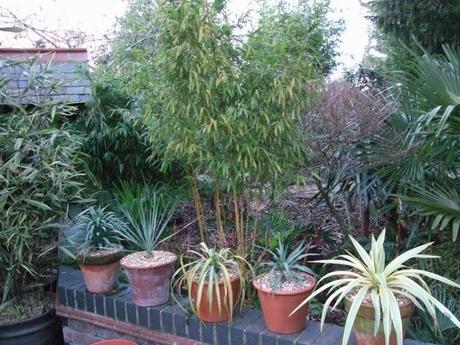
Looking bright, even on a gray winter's day
So there it was, a new plant to me, and then there was also the question: Will it be hardy? I was sure it would be, it is a variety of the tried and long tested Yucca gloriosa after all. But one must not always assume...Then much later on in the latter part of 2010 we spotted rows and rows of it at a nearby general garden center. And it came in two different sizes too, complete with shiny new tags implying that it is new on the market and belonging to a 'trendy range of plants fit for a contemporary garden'. Looks like the tissue culture industry has been successful in propagating this plant and that there will be plenty available to supply garden centres all over. So from rare to definitely not rare any more. Not that it mattered anyway, I was actually happy to see that there were plenty available and we could have more than one for our garden if we choose to. However, with the shiny labels came hefty price tags, much more than I was prepared to pay. The winter months were still about to come then and didn't want to add more plants to overwinter ourselves. And besides, as there were plenty I'm sure they wouldn't sell out by the time spring comes. So we went away without buying any.
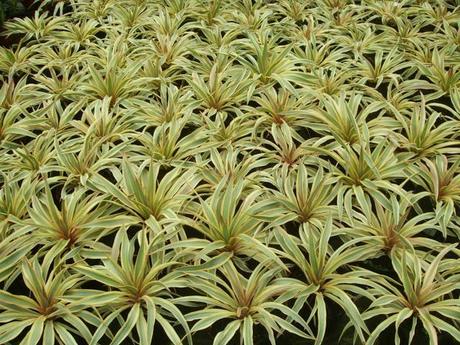
A tissue culture success story...
And that turned out to be a really good decision for what followed afterwards was the memorable winter of 2010-2011. Just before Christmas we popped round the same garden center to pick up a few gifts and saw all of the yuccas out in the open and covered by a thick layer of snow. And on another visit just after the New Year they were still covered in snow even though the temperatures had turned slightly warmer (albeit not warm enough to melt all of the snow instantly, hence the white stuff lingered on everywhere for quite some time).By early April, as we visited the garden center again in preparation for the spring, there they were, the same lot of yuccas in exactly the same position as they were. But this time half of them were dead, with the spears pulled and rotted down to virtually a tiny stump. But the other half were alive, and not just alive but also looking pristine like they had never even experienced winter at all. And even better, those that were alive were marked down in price to 50% off. Bargain! So I bought two, one small and one of the larger ones.
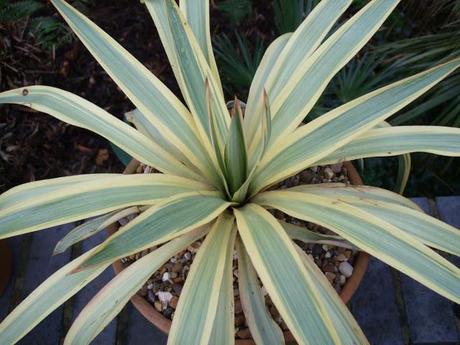
The small survivor...
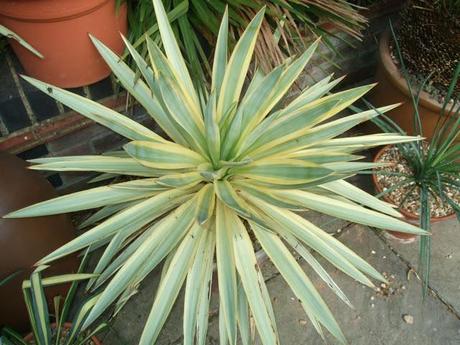
And the bigger one
So is it hardy? I reckon so. The ones bought in that garden center have been through a tough winter and sailed through fine, so as expected they were fine through last winter. So how come that batch had a fifty percent casualty? Well in my opinion I wouldn't put that with the ultimate hardiness of this plant but rather as a result of the erratic nature of new plants that were produced en masse via tissue culture. Tissue culture is good, it is an efficient way of propagating plants and ensures that supplies of desirable plants meets demands. It does however has its fair share of aberrations and unpredictability of the performance of the plants that were produced from it (not always as good as the original material where they all came from). So what is the scientific explanation behind it all? Ha! I better leave it as that, as this blog is not the right sort of place to explain such things....Anyway, fast track to this year I have seen this yucca for sale in virtually every garden center we have visited so far, including plant fairs and other nurseries (who augment their self propagated stocks by buying a few liners of tissue cultured plants). But despite their presence in left, right, and centre, the appeal to me has never diminished and still find myself gravitating towards them whenever I see them.

However, as much as I like them for their 'in your face' brightness, it is also this brightness that gives them a disadvantage for this plant is very difficult to place in the garden. It is difficult to blend in with existing color schemes as it is always bound to stand out, nor is it easy to use as a complement with other plants, being bound to overwhelm all others by its brightness. As a plant for a focal point I think it will be effective. And what about planting several instead of just one? I think that will be effective too
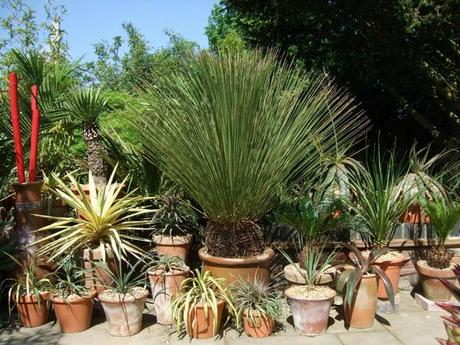
It will stand out anywhere you place it. Can you spot where it is in this picture??
Personally it doesn't bother me and just happy enough to see it shining brightly on the patio, standing out from the other yuccas and plants beside it. Perhaps I may even buy a few more, especially once the sales start in the run up to Christmas (and more after it).What I would like to achieve eventually is to have several trunked specimens, preferably solitary spheres of top of a single trunk. That will look nice with a lot more height to it, with a look similar to that of trunked Cordyline australis 'Torbay Dazzler', only this time with stiffer leaves and significantly much hardier.
As for cultural requirements, it seems just as unfussy as its species Yucca gloriosa and its more commonly found variegated form Yucca gloriosa 'Variegata'. It's a bit vague and general I know but personally I prefer not to give out rules with regards to cultural requirements of most plants, preferring to only mention hints or tips. With regards to the pink blush, this seems induced by various types of harmless stress like being exposed to full sun or in times of cold during the depths or winter. Or even with the new flush of growth during spring.
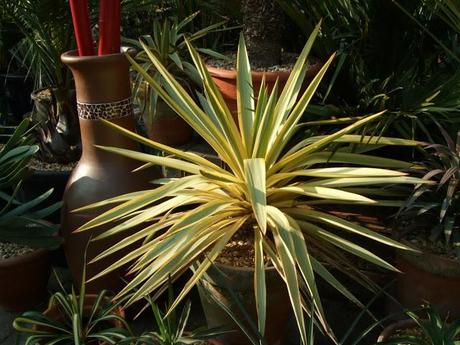
Yucca gloriosa 'Bright Star'
My tendency to gravitate towards this Yucca is also a reflection of general liking towards variegated yuccas in general, and would love to collect them all given the space and chance. There are a few more out there available, especially in the US and would definitely love to get hold of them in the near future. If tissue culture and mass propping would be the way to go for them to make its way here and make it easier for other gardeners to get hold of them then I'd say bring it on! Who says one has to be rare in order to be desirable? Not me at least.Mark :-)

